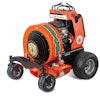
As summer winds down and you begin transitioning to the fall cleanup season, don’t forget that the fall months present a great opportunity to rejuvenate your customers’ lawns and sell additional services. Here are five services to make sure your clients purchase from you this fall.
1. Don’t Cut Too Short
In the fall, the heat and humidity of summer typically give way to cooler temperatures, encouraging grass growth. Be careful not to let the grass get too long before you mow it. As a rule of thumb, cut about a third of the grass blade at a time.
Here are some recommended mowing heights for some popular grass types:  In the fall, the heat and humidity of summer typically give way to cooler temperatures, encouraging grass growth. Be careful not to let the grass get too long before you mow it. As a rule of thumb, cut about a third of the grass blade at a time.
In the fall, the heat and humidity of summer typically give way to cooler temperatures, encouraging grass growth. Be careful not to let the grass get too long before you mow it. As a rule of thumb, cut about a third of the grass blade at a time.
Here are some recommended mowing heights for some popular grass types.
- Common Bermudagrass: 1.5”
- Kentucky Bluegrass: 2”
- Ryegrass: 2”
- St. Augustine: 2.5”
- Tall Fescue: 2.5”
- Zoysia (coarse): 1.5”
- Zoysia (fine): 1”
2. Fertilize
The fall is a good time to apply a nitrogen fertilizer to a lawn. Apply one pound per every 1,000 square feet. Unless a soil test was conducted and results show a phosphorus-deficient lawn, look for a fertilizer that does not contain phosphorus.
3. Broadleaf Weed Control
Fall is also a good time to apply a broadleaf weed herbicide as pesky weeds such as dandelions absorb the herbicide better in the fall.
4. Dethatch
A thin, half-inch layer of thatch is normal and healthy for a lawn. But thatch that’s deeper than 1 inch should be removed as it prevents air, light and water from reaching the turf's root zone. As thatch accumulates, there is a tendency for root growth to occur primarily in the thatch layer rather than the soil. This results in a weakened, poorly rooted turf that is prone to stress injury. Thatch also makes an excellent breeding ground for harmful insects and disease organisms. Use a powered dethatcher to remove excess thatch.
Read next: Fall Overseeding for a Thick, Vibrant Lawn
5. Aerate
Once you've dethatched the lawn, make sure you aerate it. Aeration allows more nutrients and water to reach the grass root zone. Fall is a good time to do it as grass plants are beginning to store food for next spring.
A core aerator removes plugs of soil. Coring holes should be at least 2.5 inches deep and no more than 3 inches apart. To get close spacing of holes, go over the lawn a second time at a 90° angle to the first pass. DO NOT aerate when it’s really wet out.




















